Critical Evaluation of the Mental Health of Children and Young People (MHCYP) Survey
VerifiedAdded on 2023/04/21
|14
|4140
|181
AI Summary
This study critically evaluates the mental health of children and young people survey in England. It discusses the research methodology, data collection, data sampling, and statistical analysis. The findings reveal the prevalence of mental disorders in different age groups and the impact of factors ...
Read More
Contribute Materials
Your contribution can guide someone’s learning journey. Share your
documents today.
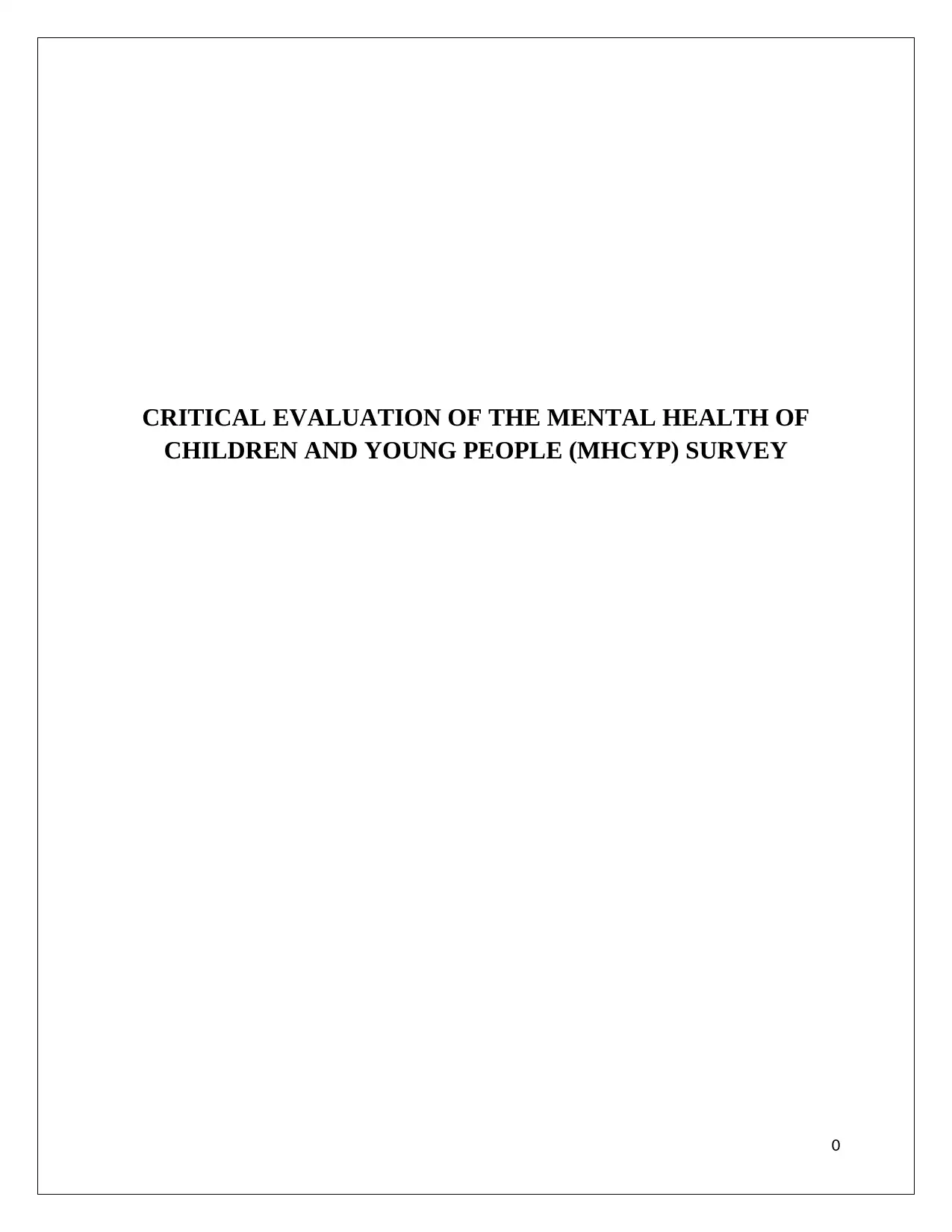
CRITICAL EVALUATION OF THE MENTAL HEALTH OF
CHILDREN AND YOUNG PEOPLE (MHCYP) SURVEY
0
CHILDREN AND YOUNG PEOPLE (MHCYP) SURVEY
0
Secure Best Marks with AI Grader
Need help grading? Try our AI Grader for instant feedback on your assignments.
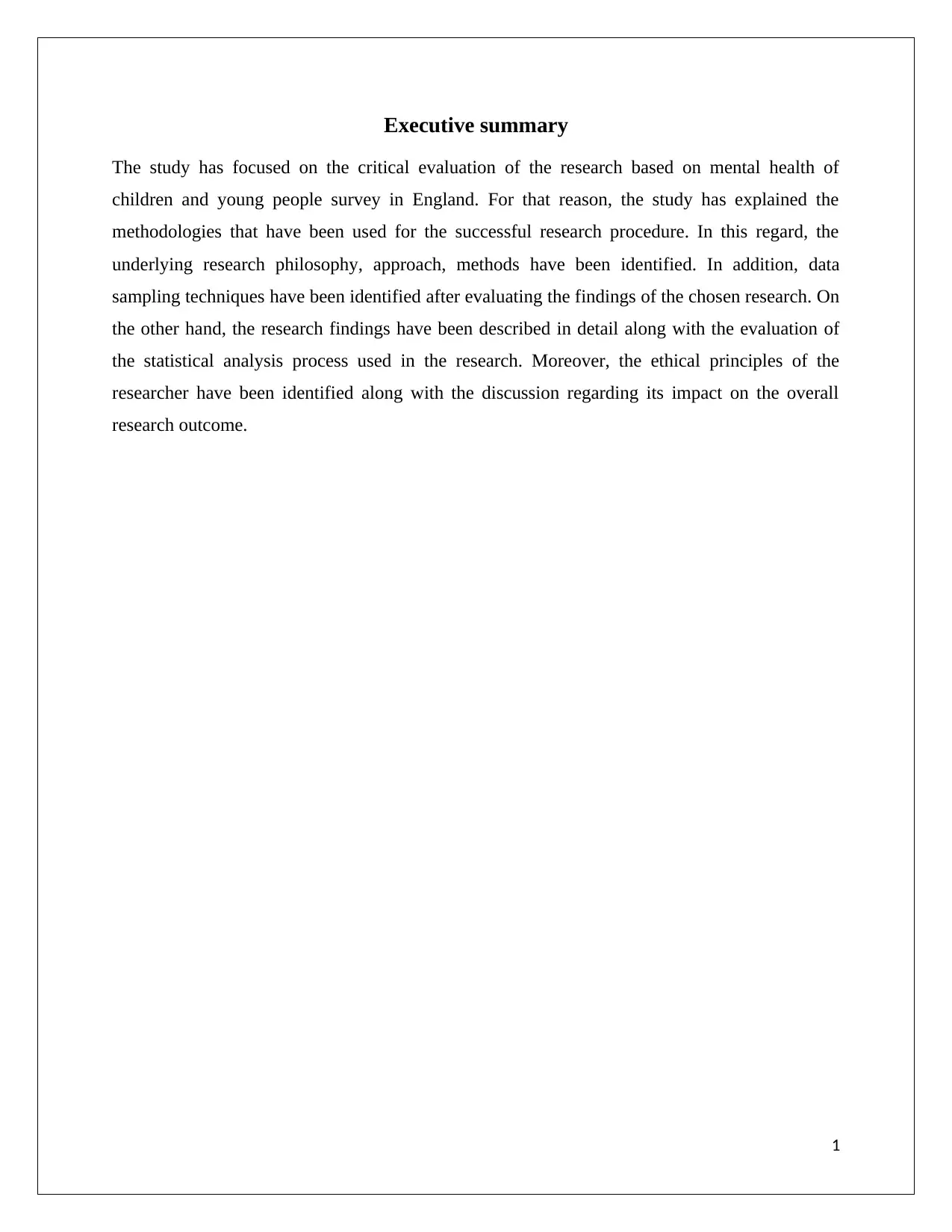
Executive summary
The study has focused on the critical evaluation of the research based on mental health of
children and young people survey in England. For that reason, the study has explained the
methodologies that have been used for the successful research procedure. In this regard, the
underlying research philosophy, approach, methods have been identified. In addition, data
sampling techniques have been identified after evaluating the findings of the chosen research. On
the other hand, the research findings have been described in detail along with the evaluation of
the statistical analysis process used in the research. Moreover, the ethical principles of the
researcher have been identified along with the discussion regarding its impact on the overall
research outcome.
1
The study has focused on the critical evaluation of the research based on mental health of
children and young people survey in England. For that reason, the study has explained the
methodologies that have been used for the successful research procedure. In this regard, the
underlying research philosophy, approach, methods have been identified. In addition, data
sampling techniques have been identified after evaluating the findings of the chosen research. On
the other hand, the research findings have been described in detail along with the evaluation of
the statistical analysis process used in the research. Moreover, the ethical principles of the
researcher have been identified along with the discussion regarding its impact on the overall
research outcome.
1
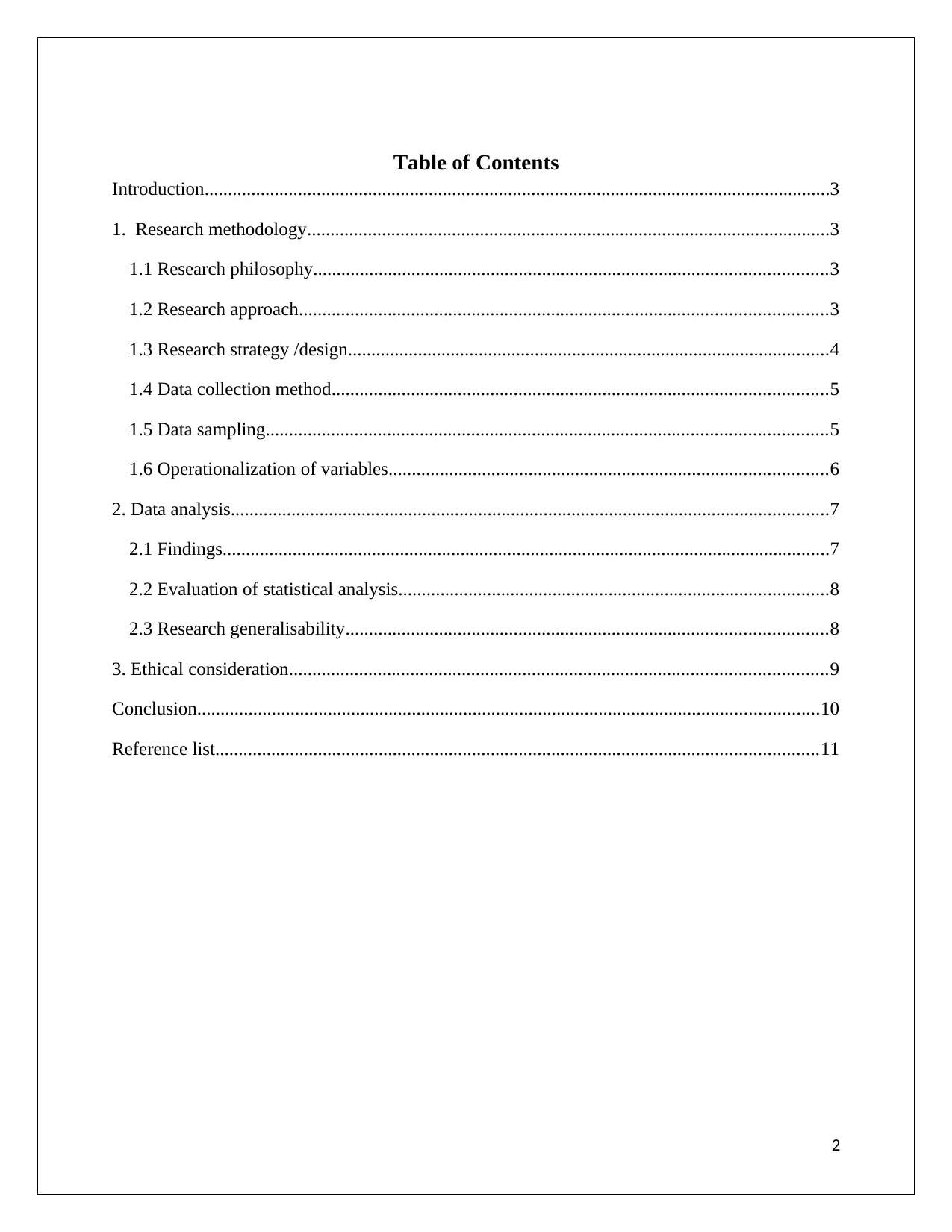
Table of Contents
Introduction......................................................................................................................................3
1. Research methodology................................................................................................................3
1.1 Research philosophy..............................................................................................................3
1.2 Research approach.................................................................................................................3
1.3 Research strategy /design.......................................................................................................4
1.4 Data collection method..........................................................................................................5
1.5 Data sampling........................................................................................................................5
1.6 Operationalization of variables..............................................................................................6
2. Data analysis................................................................................................................................7
2.1 Findings..................................................................................................................................7
2.2 Evaluation of statistical analysis............................................................................................8
2.3 Research generalisability.......................................................................................................8
3. Ethical consideration...................................................................................................................9
Conclusion.....................................................................................................................................10
Reference list.................................................................................................................................11
2
Introduction......................................................................................................................................3
1. Research methodology................................................................................................................3
1.1 Research philosophy..............................................................................................................3
1.2 Research approach.................................................................................................................3
1.3 Research strategy /design.......................................................................................................4
1.4 Data collection method..........................................................................................................5
1.5 Data sampling........................................................................................................................5
1.6 Operationalization of variables..............................................................................................6
2. Data analysis................................................................................................................................7
2.1 Findings..................................................................................................................................7
2.2 Evaluation of statistical analysis............................................................................................8
2.3 Research generalisability.......................................................................................................8
3. Ethical consideration...................................................................................................................9
Conclusion.....................................................................................................................................10
Reference list.................................................................................................................................11
2
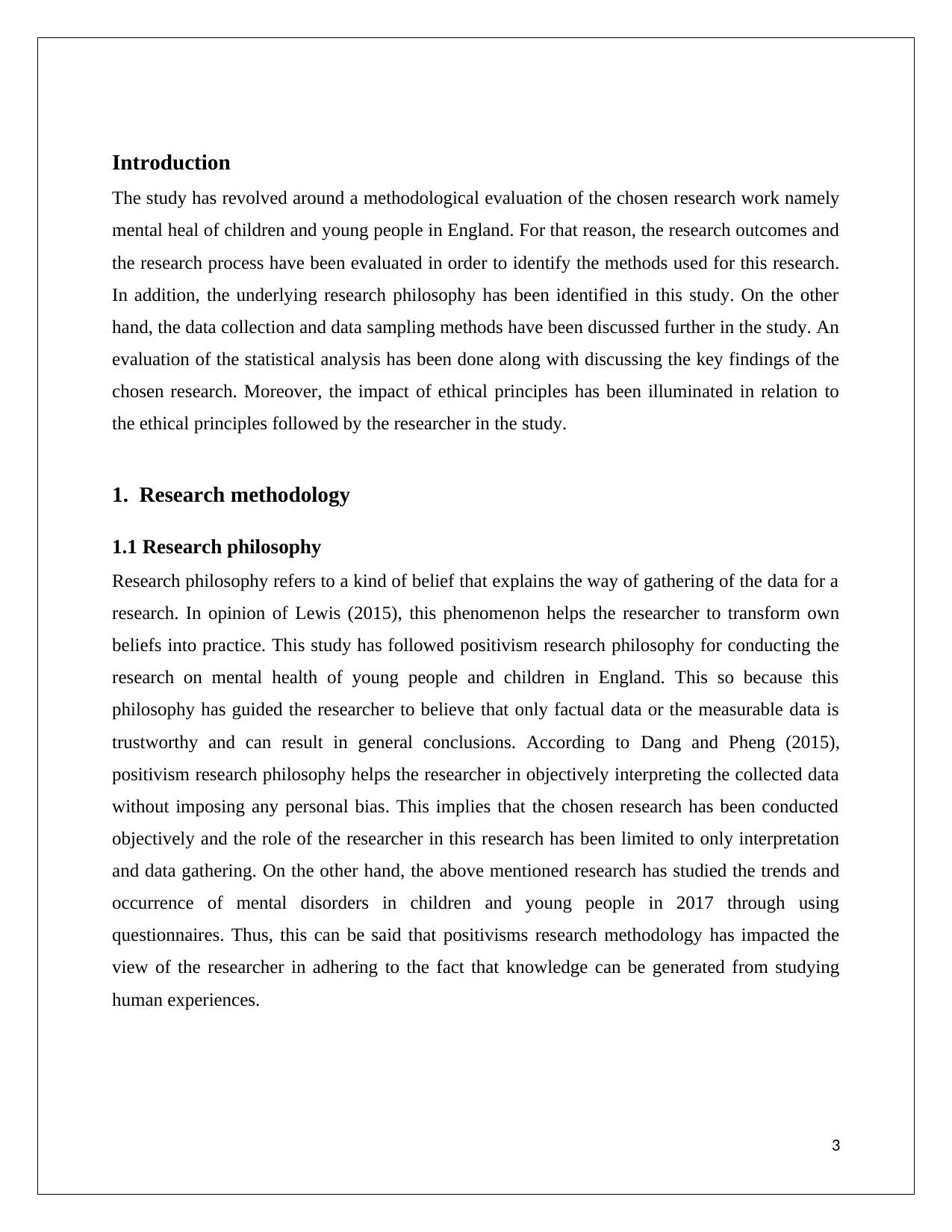
Introduction
The study has revolved around a methodological evaluation of the chosen research work namely
mental heal of children and young people in England. For that reason, the research outcomes and
the research process have been evaluated in order to identify the methods used for this research.
In addition, the underlying research philosophy has been identified in this study. On the other
hand, the data collection and data sampling methods have been discussed further in the study. An
evaluation of the statistical analysis has been done along with discussing the key findings of the
chosen research. Moreover, the impact of ethical principles has been illuminated in relation to
the ethical principles followed by the researcher in the study.
1. Research methodology
1.1 Research philosophy
Research philosophy refers to a kind of belief that explains the way of gathering of the data for a
research. In opinion of Lewis (2015), this phenomenon helps the researcher to transform own
beliefs into practice. This study has followed positivism research philosophy for conducting the
research on mental health of young people and children in England. This so because this
philosophy has guided the researcher to believe that only factual data or the measurable data is
trustworthy and can result in general conclusions. According to Dang and Pheng (2015),
positivism research philosophy helps the researcher in objectively interpreting the collected data
without imposing any personal bias. This implies that the chosen research has been conducted
objectively and the role of the researcher in this research has been limited to only interpretation
and data gathering. On the other hand, the above mentioned research has studied the trends and
occurrence of mental disorders in children and young people in 2017 through using
questionnaires. Thus, this can be said that positivisms research methodology has impacted the
view of the researcher in adhering to the fact that knowledge can be generated from studying
human experiences.
3
The study has revolved around a methodological evaluation of the chosen research work namely
mental heal of children and young people in England. For that reason, the research outcomes and
the research process have been evaluated in order to identify the methods used for this research.
In addition, the underlying research philosophy has been identified in this study. On the other
hand, the data collection and data sampling methods have been discussed further in the study. An
evaluation of the statistical analysis has been done along with discussing the key findings of the
chosen research. Moreover, the impact of ethical principles has been illuminated in relation to
the ethical principles followed by the researcher in the study.
1. Research methodology
1.1 Research philosophy
Research philosophy refers to a kind of belief that explains the way of gathering of the data for a
research. In opinion of Lewis (2015), this phenomenon helps the researcher to transform own
beliefs into practice. This study has followed positivism research philosophy for conducting the
research on mental health of young people and children in England. This so because this
philosophy has guided the researcher to believe that only factual data or the measurable data is
trustworthy and can result in general conclusions. According to Dang and Pheng (2015),
positivism research philosophy helps the researcher in objectively interpreting the collected data
without imposing any personal bias. This implies that the chosen research has been conducted
objectively and the role of the researcher in this research has been limited to only interpretation
and data gathering. On the other hand, the above mentioned research has studied the trends and
occurrence of mental disorders in children and young people in 2017 through using
questionnaires. Thus, this can be said that positivisms research methodology has impacted the
view of the researcher in adhering to the fact that knowledge can be generated from studying
human experiences.
3
Secure Best Marks with AI Grader
Need help grading? Try our AI Grader for instant feedback on your assignments.
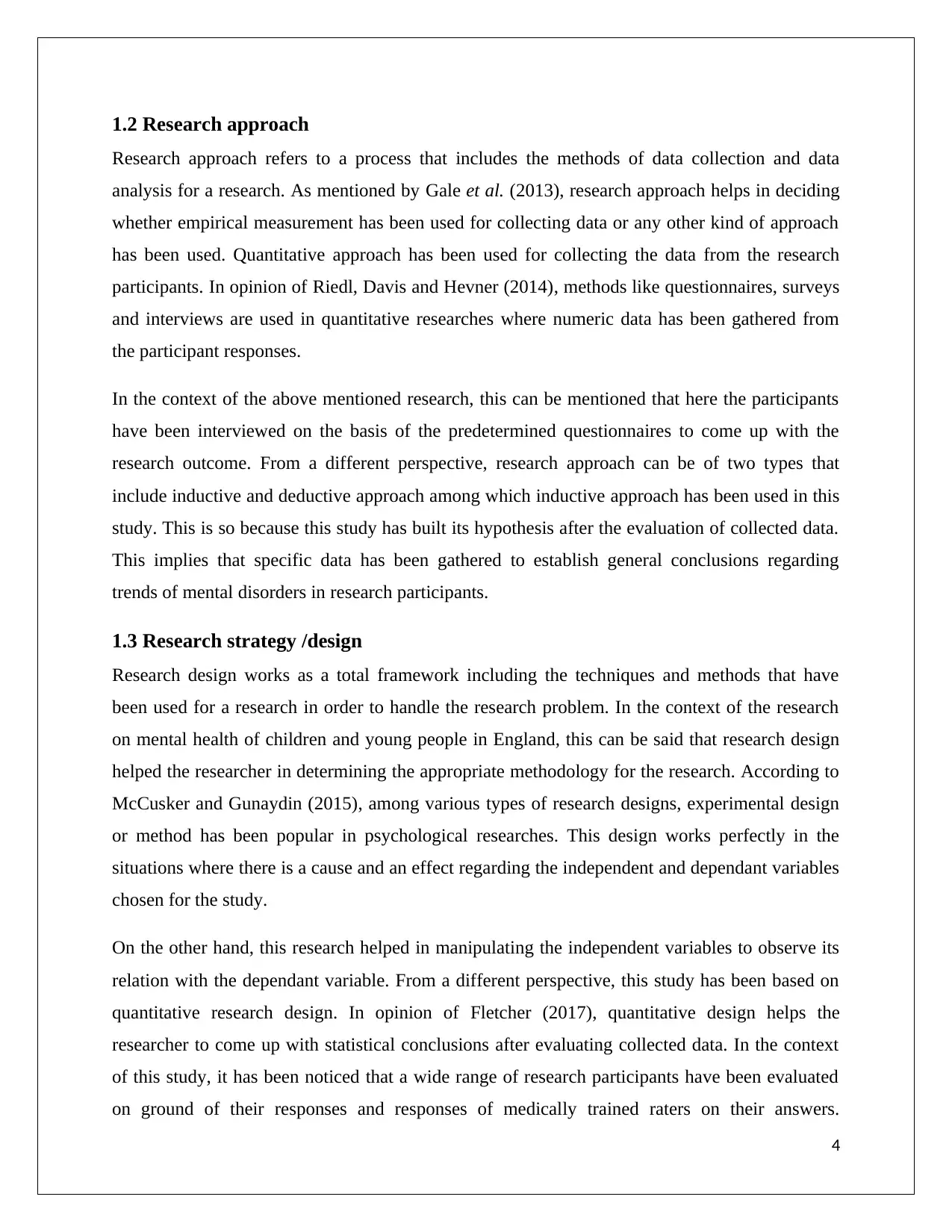
1.2 Research approach
Research approach refers to a process that includes the methods of data collection and data
analysis for a research. As mentioned by Gale et al. (2013), research approach helps in deciding
whether empirical measurement has been used for collecting data or any other kind of approach
has been used. Quantitative approach has been used for collecting the data from the research
participants. In opinion of Riedl, Davis and Hevner (2014), methods like questionnaires, surveys
and interviews are used in quantitative researches where numeric data has been gathered from
the participant responses.
In the context of the above mentioned research, this can be mentioned that here the participants
have been interviewed on the basis of the predetermined questionnaires to come up with the
research outcome. From a different perspective, research approach can be of two types that
include inductive and deductive approach among which inductive approach has been used in this
study. This is so because this study has built its hypothesis after the evaluation of collected data.
This implies that specific data has been gathered to establish general conclusions regarding
trends of mental disorders in research participants.
1.3 Research strategy /design
Research design works as a total framework including the techniques and methods that have
been used for a research in order to handle the research problem. In the context of the research
on mental health of children and young people in England, this can be said that research design
helped the researcher in determining the appropriate methodology for the research. According to
McCusker and Gunaydin (2015), among various types of research designs, experimental design
or method has been popular in psychological researches. This design works perfectly in the
situations where there is a cause and an effect regarding the independent and dependant variables
chosen for the study.
On the other hand, this research helped in manipulating the independent variables to observe its
relation with the dependant variable. From a different perspective, this study has been based on
quantitative research design. In opinion of Fletcher (2017), quantitative design helps the
researcher to come up with statistical conclusions after evaluating collected data. In the context
of this study, it has been noticed that a wide range of research participants have been evaluated
on ground of their responses and responses of medically trained raters on their answers.
4
Research approach refers to a process that includes the methods of data collection and data
analysis for a research. As mentioned by Gale et al. (2013), research approach helps in deciding
whether empirical measurement has been used for collecting data or any other kind of approach
has been used. Quantitative approach has been used for collecting the data from the research
participants. In opinion of Riedl, Davis and Hevner (2014), methods like questionnaires, surveys
and interviews are used in quantitative researches where numeric data has been gathered from
the participant responses.
In the context of the above mentioned research, this can be mentioned that here the participants
have been interviewed on the basis of the predetermined questionnaires to come up with the
research outcome. From a different perspective, research approach can be of two types that
include inductive and deductive approach among which inductive approach has been used in this
study. This is so because this study has built its hypothesis after the evaluation of collected data.
This implies that specific data has been gathered to establish general conclusions regarding
trends of mental disorders in research participants.
1.3 Research strategy /design
Research design works as a total framework including the techniques and methods that have
been used for a research in order to handle the research problem. In the context of the research
on mental health of children and young people in England, this can be said that research design
helped the researcher in determining the appropriate methodology for the research. According to
McCusker and Gunaydin (2015), among various types of research designs, experimental design
or method has been popular in psychological researches. This design works perfectly in the
situations where there is a cause and an effect regarding the independent and dependant variables
chosen for the study.
On the other hand, this research helped in manipulating the independent variables to observe its
relation with the dependant variable. From a different perspective, this study has been based on
quantitative research design. In opinion of Fletcher (2017), quantitative design helps the
researcher to come up with statistical conclusions after evaluating collected data. In the context
of this study, it has been noticed that a wide range of research participants have been evaluated
on ground of their responses and responses of medically trained raters on their answers.
4
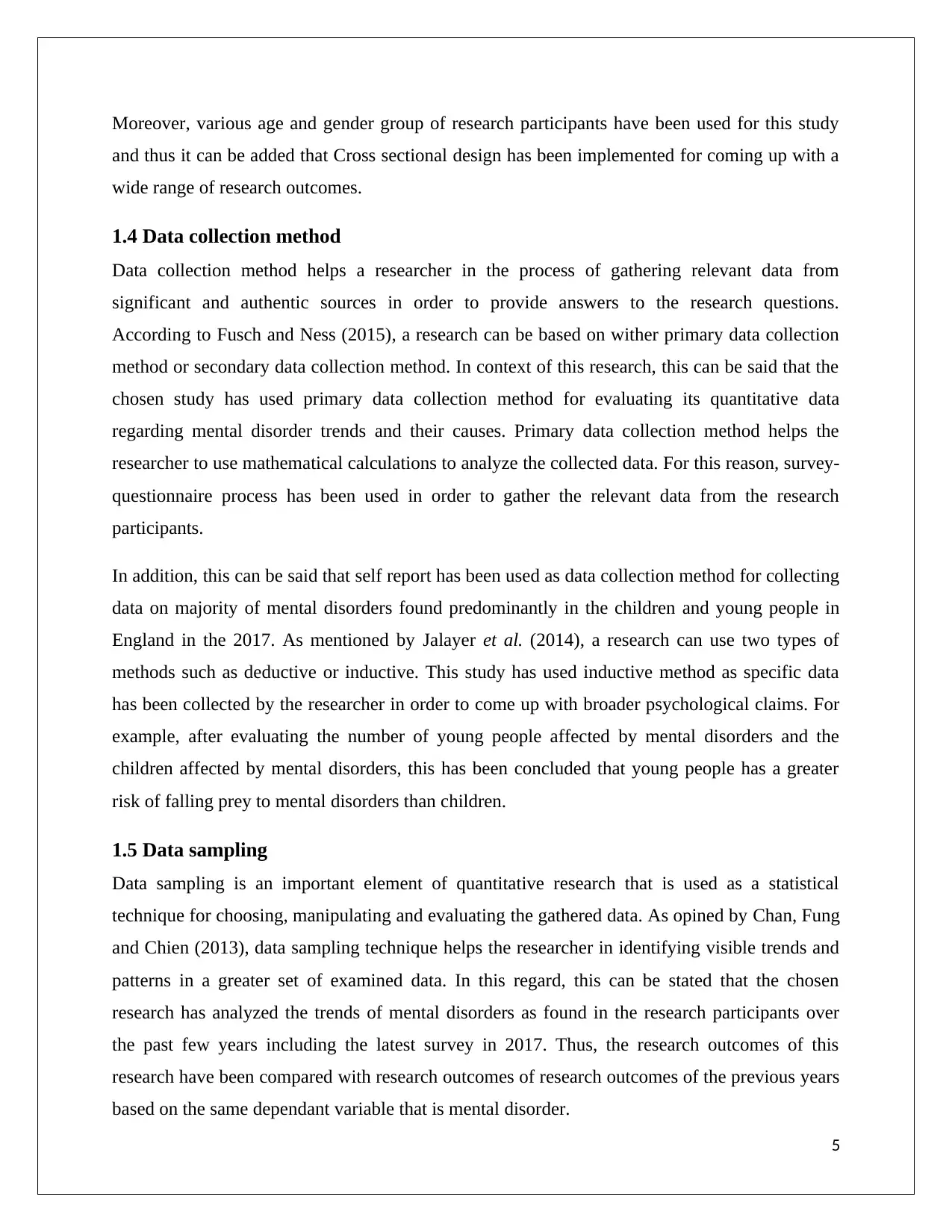
Moreover, various age and gender group of research participants have been used for this study
and thus it can be added that Cross sectional design has been implemented for coming up with a
wide range of research outcomes.
1.4 Data collection method
Data collection method helps a researcher in the process of gathering relevant data from
significant and authentic sources in order to provide answers to the research questions.
According to Fusch and Ness (2015), a research can be based on wither primary data collection
method or secondary data collection method. In context of this research, this can be said that the
chosen study has used primary data collection method for evaluating its quantitative data
regarding mental disorder trends and their causes. Primary data collection method helps the
researcher to use mathematical calculations to analyze the collected data. For this reason, survey-
questionnaire process has been used in order to gather the relevant data from the research
participants.
In addition, this can be said that self report has been used as data collection method for collecting
data on majority of mental disorders found predominantly in the children and young people in
England in the 2017. As mentioned by Jalayer et al. (2014), a research can use two types of
methods such as deductive or inductive. This study has used inductive method as specific data
has been collected by the researcher in order to come up with broader psychological claims. For
example, after evaluating the number of young people affected by mental disorders and the
children affected by mental disorders, this has been concluded that young people has a greater
risk of falling prey to mental disorders than children.
1.5 Data sampling
Data sampling is an important element of quantitative research that is used as a statistical
technique for choosing, manipulating and evaluating the gathered data. As opined by Chan, Fung
and Chien (2013), data sampling technique helps the researcher in identifying visible trends and
patterns in a greater set of examined data. In this regard, this can be stated that the chosen
research has analyzed the trends of mental disorders as found in the research participants over
the past few years including the latest survey in 2017. Thus, the research outcomes of this
research have been compared with research outcomes of research outcomes of the previous years
based on the same dependant variable that is mental disorder.
5
and thus it can be added that Cross sectional design has been implemented for coming up with a
wide range of research outcomes.
1.4 Data collection method
Data collection method helps a researcher in the process of gathering relevant data from
significant and authentic sources in order to provide answers to the research questions.
According to Fusch and Ness (2015), a research can be based on wither primary data collection
method or secondary data collection method. In context of this research, this can be said that the
chosen study has used primary data collection method for evaluating its quantitative data
regarding mental disorder trends and their causes. Primary data collection method helps the
researcher to use mathematical calculations to analyze the collected data. For this reason, survey-
questionnaire process has been used in order to gather the relevant data from the research
participants.
In addition, this can be said that self report has been used as data collection method for collecting
data on majority of mental disorders found predominantly in the children and young people in
England in the 2017. As mentioned by Jalayer et al. (2014), a research can use two types of
methods such as deductive or inductive. This study has used inductive method as specific data
has been collected by the researcher in order to come up with broader psychological claims. For
example, after evaluating the number of young people affected by mental disorders and the
children affected by mental disorders, this has been concluded that young people has a greater
risk of falling prey to mental disorders than children.
1.5 Data sampling
Data sampling is an important element of quantitative research that is used as a statistical
technique for choosing, manipulating and evaluating the gathered data. As opined by Chan, Fung
and Chien (2013), data sampling technique helps the researcher in identifying visible trends and
patterns in a greater set of examined data. In this regard, this can be stated that the chosen
research has analyzed the trends of mental disorders as found in the research participants over
the past few years including the latest survey in 2017. Thus, the research outcomes of this
research have been compared with research outcomes of research outcomes of the previous years
based on the same dependant variable that is mental disorder.
5
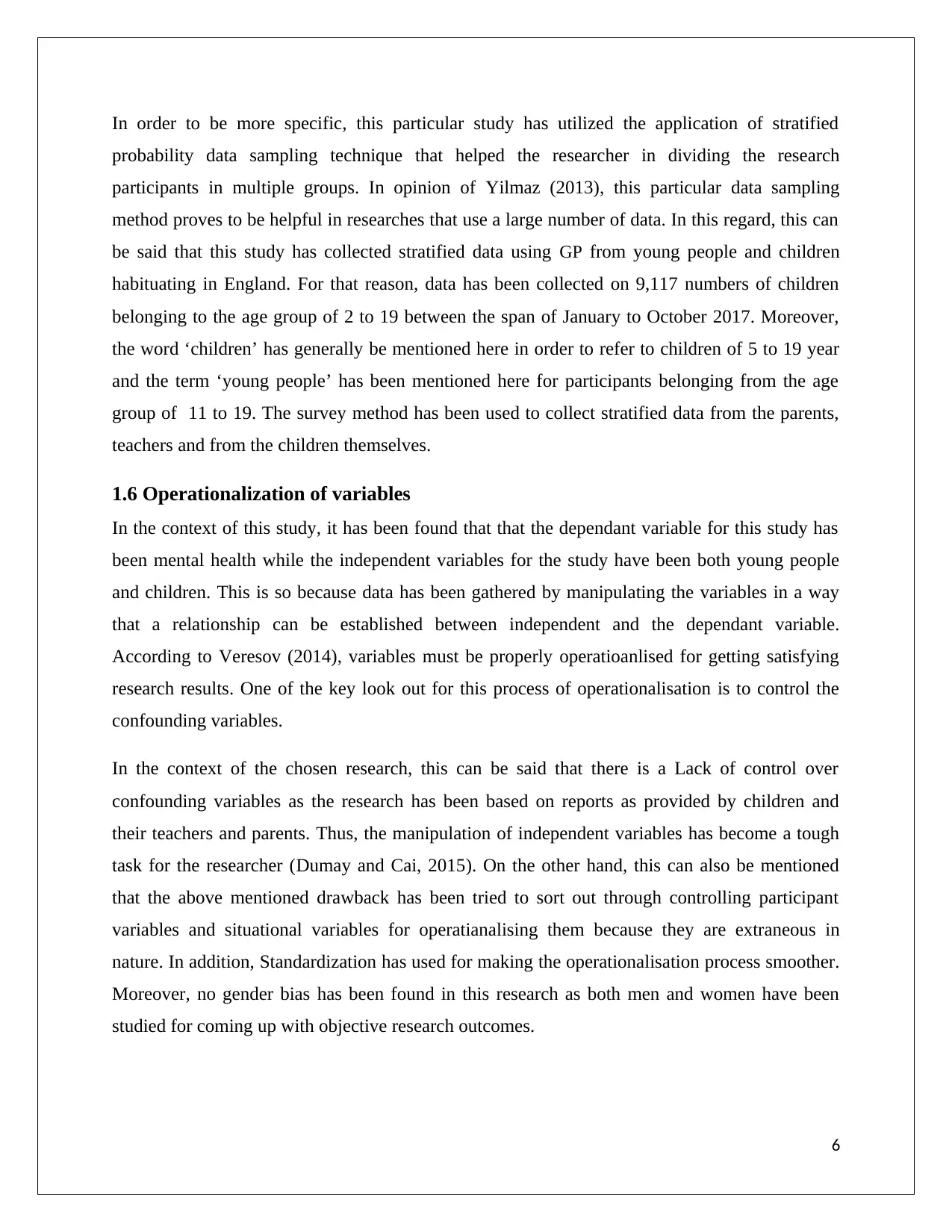
In order to be more specific, this particular study has utilized the application of stratified
probability data sampling technique that helped the researcher in dividing the research
participants in multiple groups. In opinion of Yilmaz (2013), this particular data sampling
method proves to be helpful in researches that use a large number of data. In this regard, this can
be said that this study has collected stratified data using GP from young people and children
habituating in England. For that reason, data has been collected on 9,117 numbers of children
belonging to the age group of 2 to 19 between the span of January to October 2017. Moreover,
the word ‘children’ has generally be mentioned here in order to refer to children of 5 to 19 year
and the term ‘young people’ has been mentioned here for participants belonging from the age
group of 11 to 19. The survey method has been used to collect stratified data from the parents,
teachers and from the children themselves.
1.6 Operationalization of variables
In the context of this study, it has been found that that the dependant variable for this study has
been mental health while the independent variables for the study have been both young people
and children. This is so because data has been gathered by manipulating the variables in a way
that a relationship can be established between independent and the dependant variable.
According to Veresov (2014), variables must be properly operatioanlised for getting satisfying
research results. One of the key look out for this process of operationalisation is to control the
confounding variables.
In the context of the chosen research, this can be said that there is a Lack of control over
confounding variables as the research has been based on reports as provided by children and
their teachers and parents. Thus, the manipulation of independent variables has become a tough
task for the researcher (Dumay and Cai, 2015). On the other hand, this can also be mentioned
that the above mentioned drawback has been tried to sort out through controlling participant
variables and situational variables for operatianalising them because they are extraneous in
nature. In addition, Standardization has used for making the operationalisation process smoother.
Moreover, no gender bias has been found in this research as both men and women have been
studied for coming up with objective research outcomes.
6
probability data sampling technique that helped the researcher in dividing the research
participants in multiple groups. In opinion of Yilmaz (2013), this particular data sampling
method proves to be helpful in researches that use a large number of data. In this regard, this can
be said that this study has collected stratified data using GP from young people and children
habituating in England. For that reason, data has been collected on 9,117 numbers of children
belonging to the age group of 2 to 19 between the span of January to October 2017. Moreover,
the word ‘children’ has generally be mentioned here in order to refer to children of 5 to 19 year
and the term ‘young people’ has been mentioned here for participants belonging from the age
group of 11 to 19. The survey method has been used to collect stratified data from the parents,
teachers and from the children themselves.
1.6 Operationalization of variables
In the context of this study, it has been found that that the dependant variable for this study has
been mental health while the independent variables for the study have been both young people
and children. This is so because data has been gathered by manipulating the variables in a way
that a relationship can be established between independent and the dependant variable.
According to Veresov (2014), variables must be properly operatioanlised for getting satisfying
research results. One of the key look out for this process of operationalisation is to control the
confounding variables.
In the context of the chosen research, this can be said that there is a Lack of control over
confounding variables as the research has been based on reports as provided by children and
their teachers and parents. Thus, the manipulation of independent variables has become a tough
task for the researcher (Dumay and Cai, 2015). On the other hand, this can also be mentioned
that the above mentioned drawback has been tried to sort out through controlling participant
variables and situational variables for operatianalising them because they are extraneous in
nature. In addition, Standardization has used for making the operationalisation process smoother.
Moreover, no gender bias has been found in this research as both men and women have been
studied for coming up with objective research outcomes.
6
Paraphrase This Document
Need a fresh take? Get an instant paraphrase of this document with our AI Paraphraser
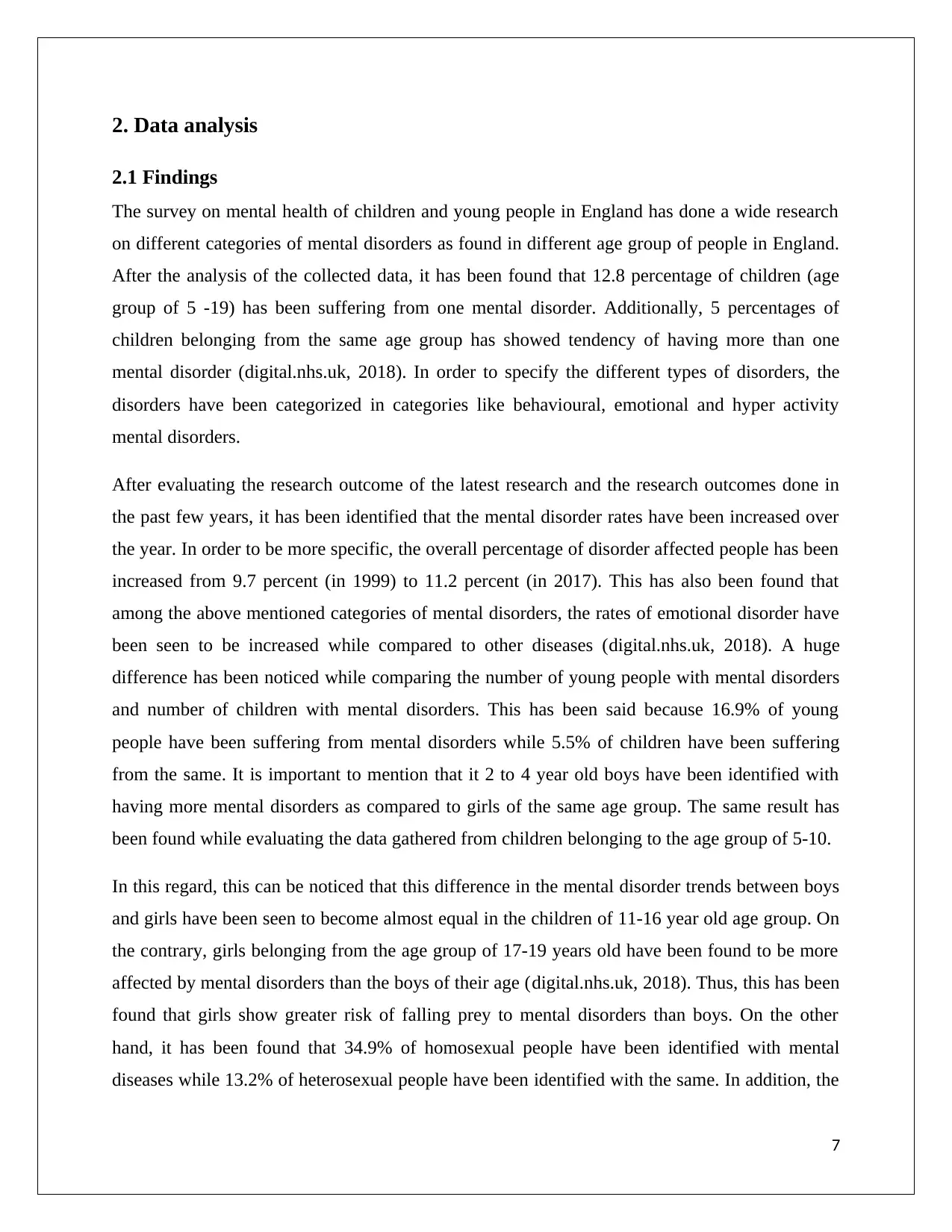
2. Data analysis
2.1 Findings
The survey on mental health of children and young people in England has done a wide research
on different categories of mental disorders as found in different age group of people in England.
After the analysis of the collected data, it has been found that 12.8 percentage of children (age
group of 5 -19) has been suffering from one mental disorder. Additionally, 5 percentages of
children belonging from the same age group has showed tendency of having more than one
mental disorder (digital.nhs.uk, 2018). In order to specify the different types of disorders, the
disorders have been categorized in categories like behavioural, emotional and hyper activity
mental disorders.
After evaluating the research outcome of the latest research and the research outcomes done in
the past few years, it has been identified that the mental disorder rates have been increased over
the year. In order to be more specific, the overall percentage of disorder affected people has been
increased from 9.7 percent (in 1999) to 11.2 percent (in 2017). This has also been found that
among the above mentioned categories of mental disorders, the rates of emotional disorder have
been seen to be increased while compared to other diseases (digital.nhs.uk, 2018). A huge
difference has been noticed while comparing the number of young people with mental disorders
and number of children with mental disorders. This has been said because 16.9% of young
people have been suffering from mental disorders while 5.5% of children have been suffering
from the same. It is important to mention that it 2 to 4 year old boys have been identified with
having more mental disorders as compared to girls of the same age group. The same result has
been found while evaluating the data gathered from children belonging to the age group of 5-10.
In this regard, this can be noticed that this difference in the mental disorder trends between boys
and girls have been seen to become almost equal in the children of 11-16 year old age group. On
the contrary, girls belonging from the age group of 17-19 years old have been found to be more
affected by mental disorders than the boys of their age (digital.nhs.uk, 2018). Thus, this has been
found that girls show greater risk of falling prey to mental disorders than boys. On the other
hand, it has been found that 34.9% of homosexual people have been identified with mental
diseases while 13.2% of heterosexual people have been identified with the same. In addition, the
7
2.1 Findings
The survey on mental health of children and young people in England has done a wide research
on different categories of mental disorders as found in different age group of people in England.
After the analysis of the collected data, it has been found that 12.8 percentage of children (age
group of 5 -19) has been suffering from one mental disorder. Additionally, 5 percentages of
children belonging from the same age group has showed tendency of having more than one
mental disorder (digital.nhs.uk, 2018). In order to specify the different types of disorders, the
disorders have been categorized in categories like behavioural, emotional and hyper activity
mental disorders.
After evaluating the research outcome of the latest research and the research outcomes done in
the past few years, it has been identified that the mental disorder rates have been increased over
the year. In order to be more specific, the overall percentage of disorder affected people has been
increased from 9.7 percent (in 1999) to 11.2 percent (in 2017). This has also been found that
among the above mentioned categories of mental disorders, the rates of emotional disorder have
been seen to be increased while compared to other diseases (digital.nhs.uk, 2018). A huge
difference has been noticed while comparing the number of young people with mental disorders
and number of children with mental disorders. This has been said because 16.9% of young
people have been suffering from mental disorders while 5.5% of children have been suffering
from the same. It is important to mention that it 2 to 4 year old boys have been identified with
having more mental disorders as compared to girls of the same age group. The same result has
been found while evaluating the data gathered from children belonging to the age group of 5-10.
In this regard, this can be noticed that this difference in the mental disorder trends between boys
and girls have been seen to become almost equal in the children of 11-16 year old age group. On
the contrary, girls belonging from the age group of 17-19 years old have been found to be more
affected by mental disorders than the boys of their age (digital.nhs.uk, 2018). Thus, this has been
found that girls show greater risk of falling prey to mental disorders than boys. On the other
hand, it has been found that 34.9% of homosexual people have been identified with mental
diseases while 13.2% of heterosexual people have been identified with the same. In addition, the
7
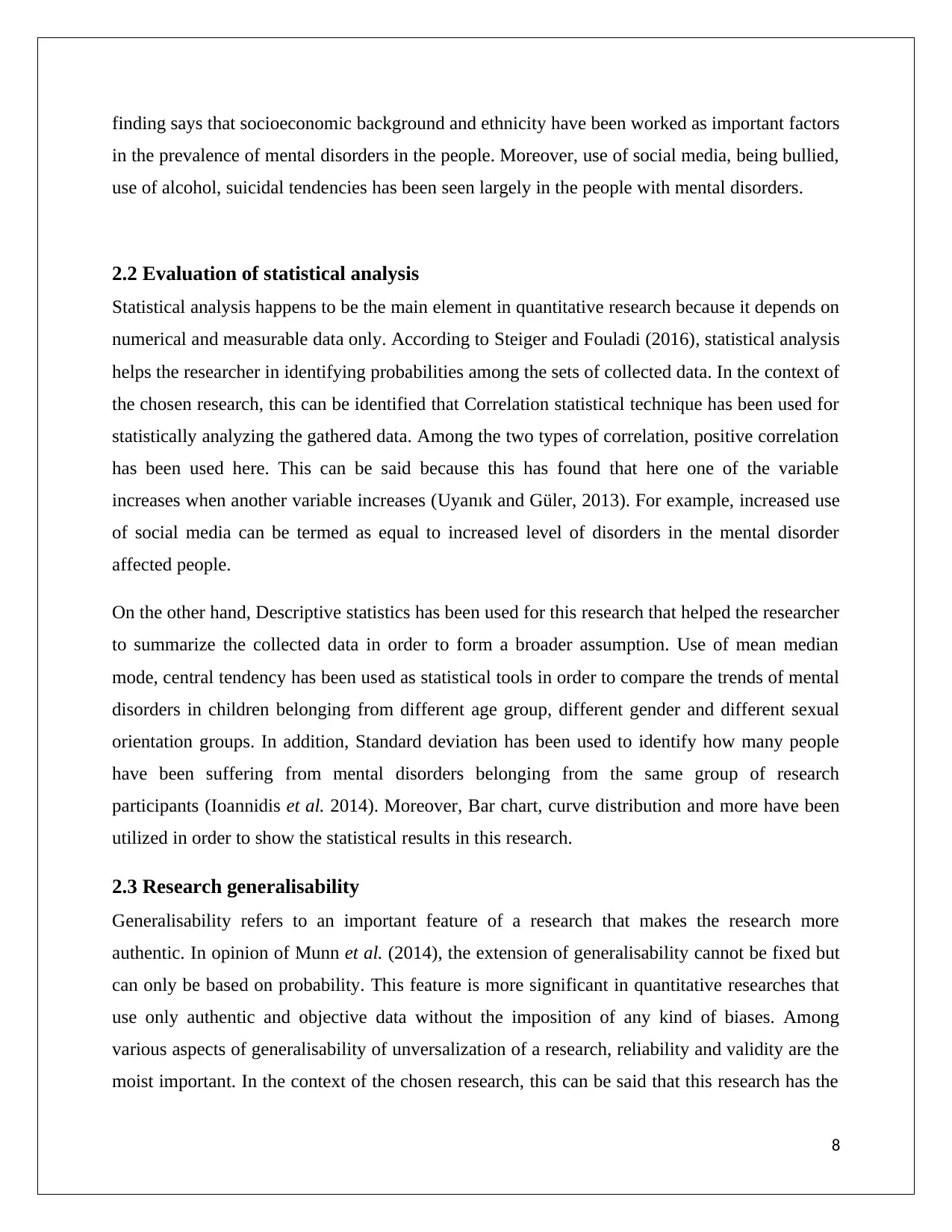
finding says that socioeconomic background and ethnicity have been worked as important factors
in the prevalence of mental disorders in the people. Moreover, use of social media, being bullied,
use of alcohol, suicidal tendencies has been seen largely in the people with mental disorders.
2.2 Evaluation of statistical analysis
Statistical analysis happens to be the main element in quantitative research because it depends on
numerical and measurable data only. According to Steiger and Fouladi (2016), statistical analysis
helps the researcher in identifying probabilities among the sets of collected data. In the context of
the chosen research, this can be identified that Correlation statistical technique has been used for
statistically analyzing the gathered data. Among the two types of correlation, positive correlation
has been used here. This can be said because this has found that here one of the variable
increases when another variable increases (Uyanık and Güler, 2013). For example, increased use
of social media can be termed as equal to increased level of disorders in the mental disorder
affected people.
On the other hand, Descriptive statistics has been used for this research that helped the researcher
to summarize the collected data in order to form a broader assumption. Use of mean median
mode, central tendency has been used as statistical tools in order to compare the trends of mental
disorders in children belonging from different age group, different gender and different sexual
orientation groups. In addition, Standard deviation has been used to identify how many people
have been suffering from mental disorders belonging from the same group of research
participants (Ioannidis et al. 2014). Moreover, Bar chart, curve distribution and more have been
utilized in order to show the statistical results in this research.
2.3 Research generalisability
Generalisability refers to an important feature of a research that makes the research more
authentic. In opinion of Munn et al. (2014), the extension of generalisability cannot be fixed but
can only be based on probability. This feature is more significant in quantitative researches that
use only authentic and objective data without the imposition of any kind of biases. Among
various aspects of generalisability of unversalization of a research, reliability and validity are the
moist important. In the context of the chosen research, this can be said that this research has the
8
in the prevalence of mental disorders in the people. Moreover, use of social media, being bullied,
use of alcohol, suicidal tendencies has been seen largely in the people with mental disorders.
2.2 Evaluation of statistical analysis
Statistical analysis happens to be the main element in quantitative research because it depends on
numerical and measurable data only. According to Steiger and Fouladi (2016), statistical analysis
helps the researcher in identifying probabilities among the sets of collected data. In the context of
the chosen research, this can be identified that Correlation statistical technique has been used for
statistically analyzing the gathered data. Among the two types of correlation, positive correlation
has been used here. This can be said because this has found that here one of the variable
increases when another variable increases (Uyanık and Güler, 2013). For example, increased use
of social media can be termed as equal to increased level of disorders in the mental disorder
affected people.
On the other hand, Descriptive statistics has been used for this research that helped the researcher
to summarize the collected data in order to form a broader assumption. Use of mean median
mode, central tendency has been used as statistical tools in order to compare the trends of mental
disorders in children belonging from different age group, different gender and different sexual
orientation groups. In addition, Standard deviation has been used to identify how many people
have been suffering from mental disorders belonging from the same group of research
participants (Ioannidis et al. 2014). Moreover, Bar chart, curve distribution and more have been
utilized in order to show the statistical results in this research.
2.3 Research generalisability
Generalisability refers to an important feature of a research that makes the research more
authentic. In opinion of Munn et al. (2014), the extension of generalisability cannot be fixed but
can only be based on probability. This feature is more significant in quantitative researches that
use only authentic and objective data without the imposition of any kind of biases. Among
various aspects of generalisability of unversalization of a research, reliability and validity are the
moist important. In the context of the chosen research, this can be said that this research has the
8
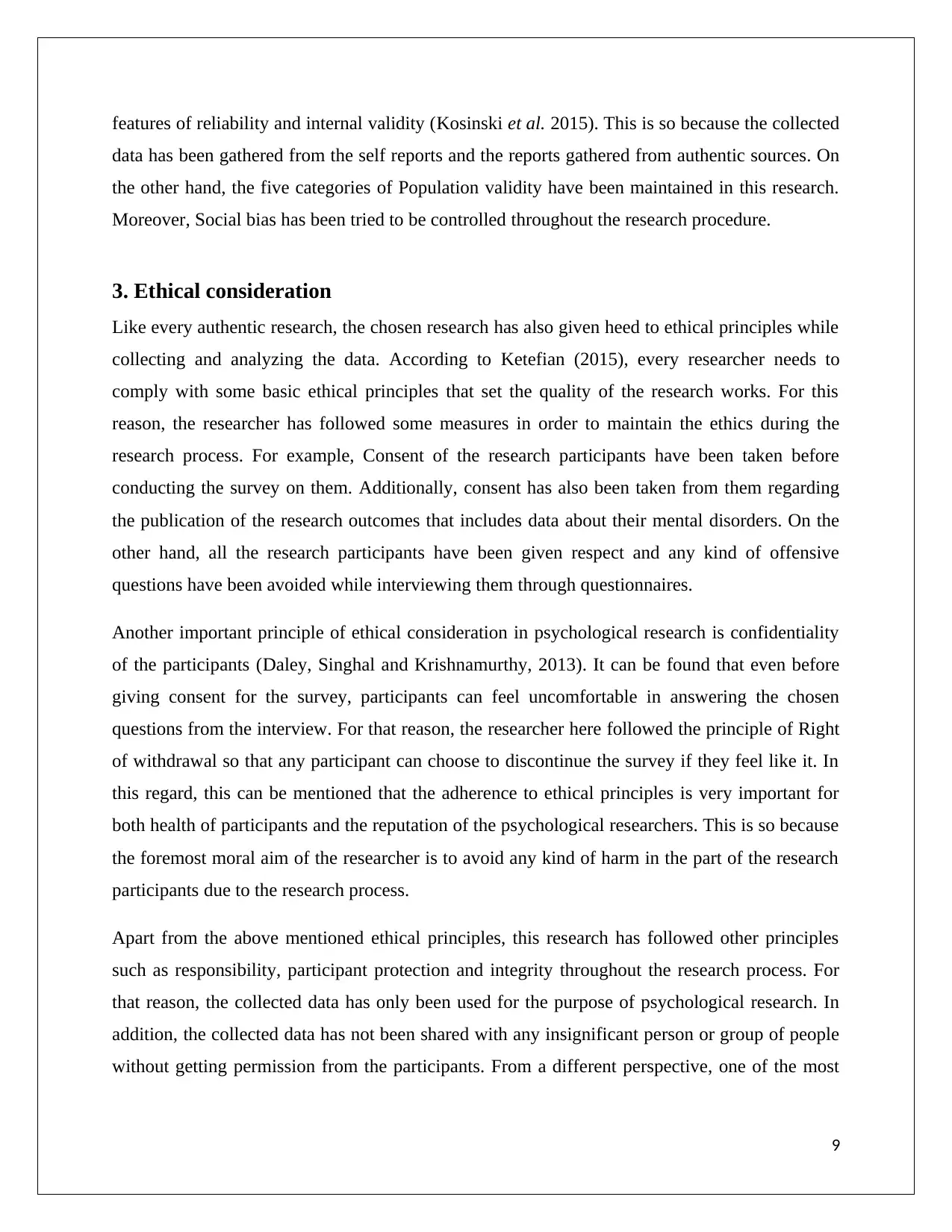
features of reliability and internal validity (Kosinski et al. 2015). This is so because the collected
data has been gathered from the self reports and the reports gathered from authentic sources. On
the other hand, the five categories of Population validity have been maintained in this research.
Moreover, Social bias has been tried to be controlled throughout the research procedure.
3. Ethical consideration
Like every authentic research, the chosen research has also given heed to ethical principles while
collecting and analyzing the data. According to Ketefian (2015), every researcher needs to
comply with some basic ethical principles that set the quality of the research works. For this
reason, the researcher has followed some measures in order to maintain the ethics during the
research process. For example, Consent of the research participants have been taken before
conducting the survey on them. Additionally, consent has also been taken from them regarding
the publication of the research outcomes that includes data about their mental disorders. On the
other hand, all the research participants have been given respect and any kind of offensive
questions have been avoided while interviewing them through questionnaires.
Another important principle of ethical consideration in psychological research is confidentiality
of the participants (Daley, Singhal and Krishnamurthy, 2013). It can be found that even before
giving consent for the survey, participants can feel uncomfortable in answering the chosen
questions from the interview. For that reason, the researcher here followed the principle of Right
of withdrawal so that any participant can choose to discontinue the survey if they feel like it. In
this regard, this can be mentioned that the adherence to ethical principles is very important for
both health of participants and the reputation of the psychological researchers. This is so because
the foremost moral aim of the researcher is to avoid any kind of harm in the part of the research
participants due to the research process.
Apart from the above mentioned ethical principles, this research has followed other principles
such as responsibility, participant protection and integrity throughout the research process. For
that reason, the collected data has only been used for the purpose of psychological research. In
addition, the collected data has not been shared with any insignificant person or group of people
without getting permission from the participants. From a different perspective, one of the most
9
data has been gathered from the self reports and the reports gathered from authentic sources. On
the other hand, the five categories of Population validity have been maintained in this research.
Moreover, Social bias has been tried to be controlled throughout the research procedure.
3. Ethical consideration
Like every authentic research, the chosen research has also given heed to ethical principles while
collecting and analyzing the data. According to Ketefian (2015), every researcher needs to
comply with some basic ethical principles that set the quality of the research works. For this
reason, the researcher has followed some measures in order to maintain the ethics during the
research process. For example, Consent of the research participants have been taken before
conducting the survey on them. Additionally, consent has also been taken from them regarding
the publication of the research outcomes that includes data about their mental disorders. On the
other hand, all the research participants have been given respect and any kind of offensive
questions have been avoided while interviewing them through questionnaires.
Another important principle of ethical consideration in psychological research is confidentiality
of the participants (Daley, Singhal and Krishnamurthy, 2013). It can be found that even before
giving consent for the survey, participants can feel uncomfortable in answering the chosen
questions from the interview. For that reason, the researcher here followed the principle of Right
of withdrawal so that any participant can choose to discontinue the survey if they feel like it. In
this regard, this can be mentioned that the adherence to ethical principles is very important for
both health of participants and the reputation of the psychological researchers. This is so because
the foremost moral aim of the researcher is to avoid any kind of harm in the part of the research
participants due to the research process.
Apart from the above mentioned ethical principles, this research has followed other principles
such as responsibility, participant protection and integrity throughout the research process. For
that reason, the collected data has only been used for the purpose of psychological research. In
addition, the collected data has not been shared with any insignificant person or group of people
without getting permission from the participants. From a different perspective, one of the most
9
Secure Best Marks with AI Grader
Need help grading? Try our AI Grader for instant feedback on your assignments.
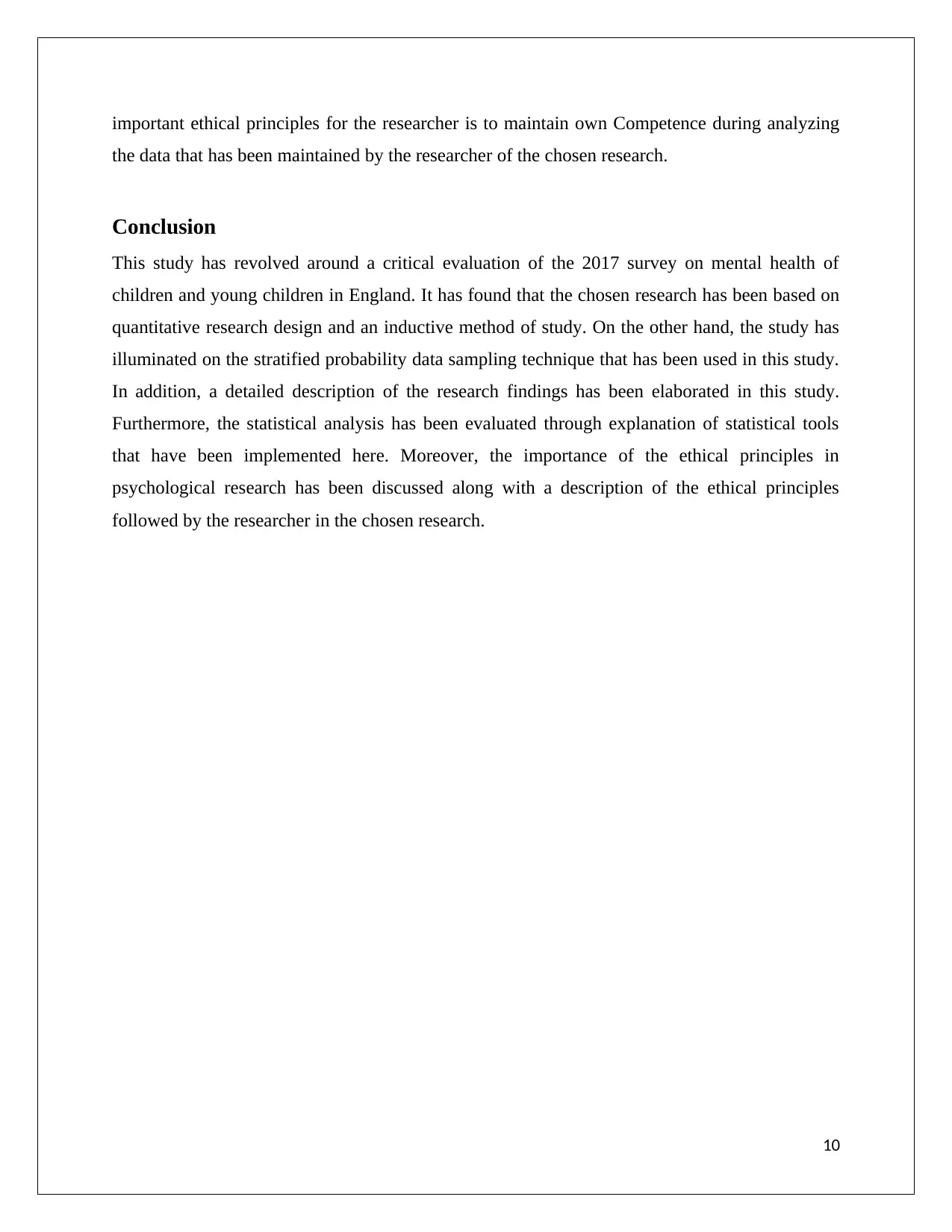
important ethical principles for the researcher is to maintain own Competence during analyzing
the data that has been maintained by the researcher of the chosen research.
Conclusion
This study has revolved around a critical evaluation of the 2017 survey on mental health of
children and young children in England. It has found that the chosen research has been based on
quantitative research design and an inductive method of study. On the other hand, the study has
illuminated on the stratified probability data sampling technique that has been used in this study.
In addition, a detailed description of the research findings has been elaborated in this study.
Furthermore, the statistical analysis has been evaluated through explanation of statistical tools
that have been implemented here. Moreover, the importance of the ethical principles in
psychological research has been discussed along with a description of the ethical principles
followed by the researcher in the chosen research.
10
the data that has been maintained by the researcher of the chosen research.
Conclusion
This study has revolved around a critical evaluation of the 2017 survey on mental health of
children and young children in England. It has found that the chosen research has been based on
quantitative research design and an inductive method of study. On the other hand, the study has
illuminated on the stratified probability data sampling technique that has been used in this study.
In addition, a detailed description of the research findings has been elaborated in this study.
Furthermore, the statistical analysis has been evaluated through explanation of statistical tools
that have been implemented here. Moreover, the importance of the ethical principles in
psychological research has been discussed along with a description of the ethical principles
followed by the researcher in the chosen research.
10
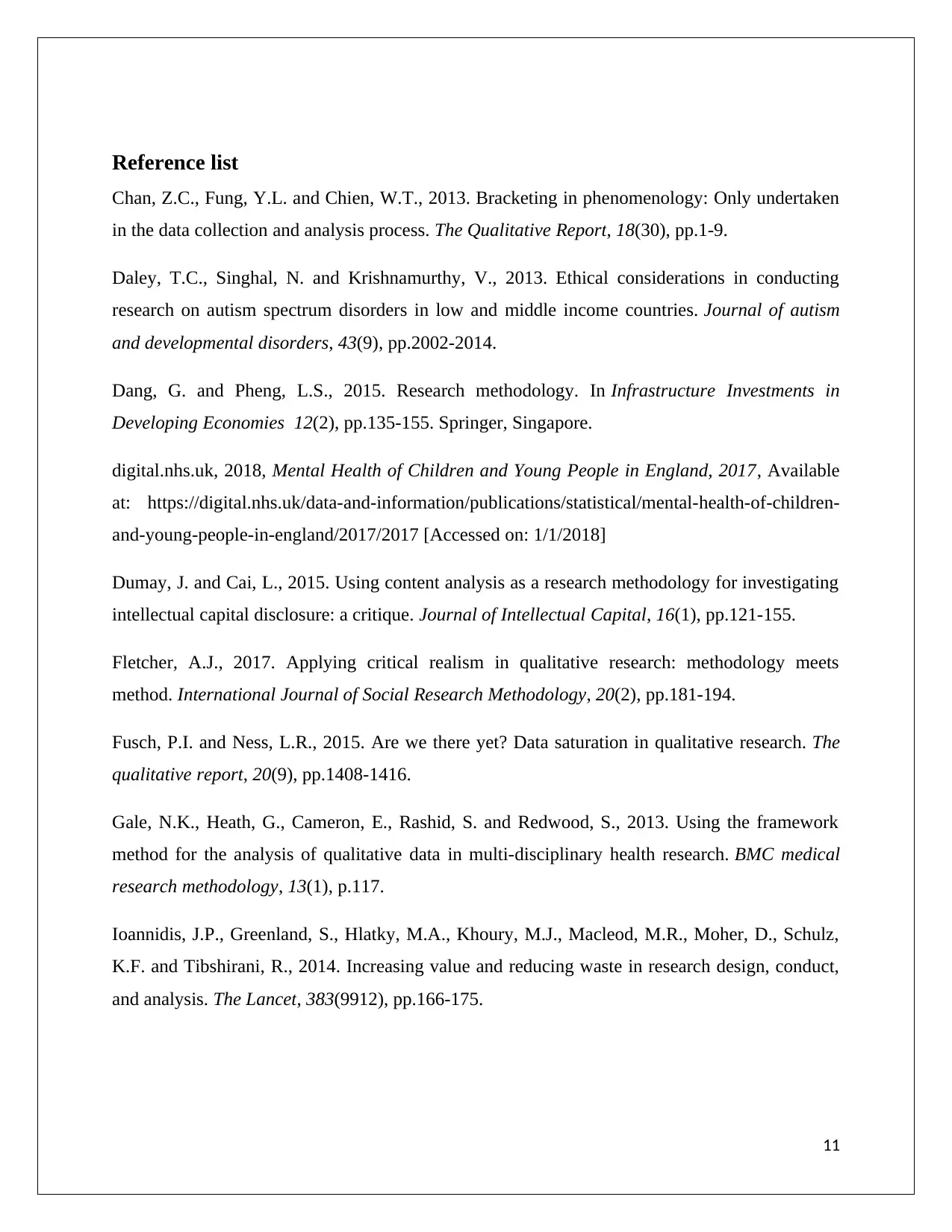
Reference list
Chan, Z.C., Fung, Y.L. and Chien, W.T., 2013. Bracketing in phenomenology: Only undertaken
in the data collection and analysis process. The Qualitative Report, 18(30), pp.1-9.
Daley, T.C., Singhal, N. and Krishnamurthy, V., 2013. Ethical considerations in conducting
research on autism spectrum disorders in low and middle income countries. Journal of autism
and developmental disorders, 43(9), pp.2002-2014.
Dang, G. and Pheng, L.S., 2015. Research methodology. In Infrastructure Investments in
Developing Economies 12(2), pp.135-155. Springer, Singapore.
digital.nhs.uk, 2018, Mental Health of Children and Young People in England, 2017, Available
at: https://digital.nhs.uk/data-and-information/publications/statistical/mental-health-of-children-
and-young-people-in-england/2017/2017 [Accessed on: 1/1/2018]
Dumay, J. and Cai, L., 2015. Using content analysis as a research methodology for investigating
intellectual capital disclosure: a critique. Journal of Intellectual Capital, 16(1), pp.121-155.
Fletcher, A.J., 2017. Applying critical realism in qualitative research: methodology meets
method. International Journal of Social Research Methodology, 20(2), pp.181-194.
Fusch, P.I. and Ness, L.R., 2015. Are we there yet? Data saturation in qualitative research. The
qualitative report, 20(9), pp.1408-1416.
Gale, N.K., Heath, G., Cameron, E., Rashid, S. and Redwood, S., 2013. Using the framework
method for the analysis of qualitative data in multi-disciplinary health research. BMC medical
research methodology, 13(1), p.117.
Ioannidis, J.P., Greenland, S., Hlatky, M.A., Khoury, M.J., Macleod, M.R., Moher, D., Schulz,
K.F. and Tibshirani, R., 2014. Increasing value and reducing waste in research design, conduct,
and analysis. The Lancet, 383(9912), pp.166-175.
11
Chan, Z.C., Fung, Y.L. and Chien, W.T., 2013. Bracketing in phenomenology: Only undertaken
in the data collection and analysis process. The Qualitative Report, 18(30), pp.1-9.
Daley, T.C., Singhal, N. and Krishnamurthy, V., 2013. Ethical considerations in conducting
research on autism spectrum disorders in low and middle income countries. Journal of autism
and developmental disorders, 43(9), pp.2002-2014.
Dang, G. and Pheng, L.S., 2015. Research methodology. In Infrastructure Investments in
Developing Economies 12(2), pp.135-155. Springer, Singapore.
digital.nhs.uk, 2018, Mental Health of Children and Young People in England, 2017, Available
at: https://digital.nhs.uk/data-and-information/publications/statistical/mental-health-of-children-
and-young-people-in-england/2017/2017 [Accessed on: 1/1/2018]
Dumay, J. and Cai, L., 2015. Using content analysis as a research methodology for investigating
intellectual capital disclosure: a critique. Journal of Intellectual Capital, 16(1), pp.121-155.
Fletcher, A.J., 2017. Applying critical realism in qualitative research: methodology meets
method. International Journal of Social Research Methodology, 20(2), pp.181-194.
Fusch, P.I. and Ness, L.R., 2015. Are we there yet? Data saturation in qualitative research. The
qualitative report, 20(9), pp.1408-1416.
Gale, N.K., Heath, G., Cameron, E., Rashid, S. and Redwood, S., 2013. Using the framework
method for the analysis of qualitative data in multi-disciplinary health research. BMC medical
research methodology, 13(1), p.117.
Ioannidis, J.P., Greenland, S., Hlatky, M.A., Khoury, M.J., Macleod, M.R., Moher, D., Schulz,
K.F. and Tibshirani, R., 2014. Increasing value and reducing waste in research design, conduct,
and analysis. The Lancet, 383(9912), pp.166-175.
11
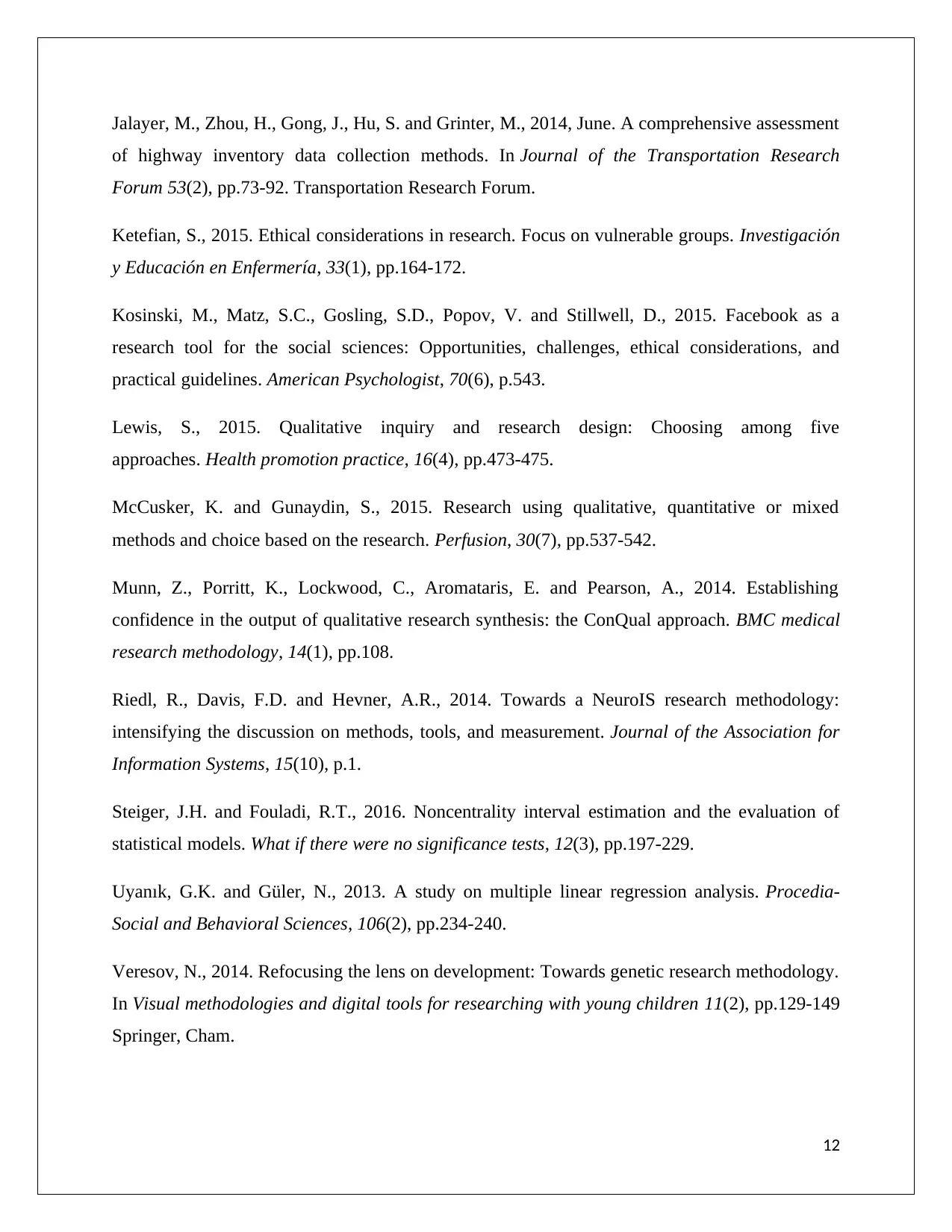
Jalayer, M., Zhou, H., Gong, J., Hu, S. and Grinter, M., 2014, June. A comprehensive assessment
of highway inventory data collection methods. In Journal of the Transportation Research
Forum 53(2), pp.73-92. Transportation Research Forum.
Ketefian, S., 2015. Ethical considerations in research. Focus on vulnerable groups. Investigación
y Educación en Enfermería, 33(1), pp.164-172.
Kosinski, M., Matz, S.C., Gosling, S.D., Popov, V. and Stillwell, D., 2015. Facebook as a
research tool for the social sciences: Opportunities, challenges, ethical considerations, and
practical guidelines. American Psychologist, 70(6), p.543.
Lewis, S., 2015. Qualitative inquiry and research design: Choosing among five
approaches. Health promotion practice, 16(4), pp.473-475.
McCusker, K. and Gunaydin, S., 2015. Research using qualitative, quantitative or mixed
methods and choice based on the research. Perfusion, 30(7), pp.537-542.
Munn, Z., Porritt, K., Lockwood, C., Aromataris, E. and Pearson, A., 2014. Establishing
confidence in the output of qualitative research synthesis: the ConQual approach. BMC medical
research methodology, 14(1), pp.108.
Riedl, R., Davis, F.D. and Hevner, A.R., 2014. Towards a NeuroIS research methodology:
intensifying the discussion on methods, tools, and measurement. Journal of the Association for
Information Systems, 15(10), p.1.
Steiger, J.H. and Fouladi, R.T., 2016. Noncentrality interval estimation and the evaluation of
statistical models. What if there were no significance tests, 12(3), pp.197-229.
Uyanık, G.K. and Güler, N., 2013. A study on multiple linear regression analysis. Procedia-
Social and Behavioral Sciences, 106(2), pp.234-240.
Veresov, N., 2014. Refocusing the lens on development: Towards genetic research methodology.
In Visual methodologies and digital tools for researching with young children 11(2), pp.129-149
Springer, Cham.
12
of highway inventory data collection methods. In Journal of the Transportation Research
Forum 53(2), pp.73-92. Transportation Research Forum.
Ketefian, S., 2015. Ethical considerations in research. Focus on vulnerable groups. Investigación
y Educación en Enfermería, 33(1), pp.164-172.
Kosinski, M., Matz, S.C., Gosling, S.D., Popov, V. and Stillwell, D., 2015. Facebook as a
research tool for the social sciences: Opportunities, challenges, ethical considerations, and
practical guidelines. American Psychologist, 70(6), p.543.
Lewis, S., 2015. Qualitative inquiry and research design: Choosing among five
approaches. Health promotion practice, 16(4), pp.473-475.
McCusker, K. and Gunaydin, S., 2015. Research using qualitative, quantitative or mixed
methods and choice based on the research. Perfusion, 30(7), pp.537-542.
Munn, Z., Porritt, K., Lockwood, C., Aromataris, E. and Pearson, A., 2014. Establishing
confidence in the output of qualitative research synthesis: the ConQual approach. BMC medical
research methodology, 14(1), pp.108.
Riedl, R., Davis, F.D. and Hevner, A.R., 2014. Towards a NeuroIS research methodology:
intensifying the discussion on methods, tools, and measurement. Journal of the Association for
Information Systems, 15(10), p.1.
Steiger, J.H. and Fouladi, R.T., 2016. Noncentrality interval estimation and the evaluation of
statistical models. What if there were no significance tests, 12(3), pp.197-229.
Uyanık, G.K. and Güler, N., 2013. A study on multiple linear regression analysis. Procedia-
Social and Behavioral Sciences, 106(2), pp.234-240.
Veresov, N., 2014. Refocusing the lens on development: Towards genetic research methodology.
In Visual methodologies and digital tools for researching with young children 11(2), pp.129-149
Springer, Cham.
12
Paraphrase This Document
Need a fresh take? Get an instant paraphrase of this document with our AI Paraphraser

Yilmaz, K., 2013. Comparison of quantitative and qualitative research traditions:
Epistemological, theoretical, and methodological differences. European Journal of Education,
48(2), pp.311-325.
13
Epistemological, theoretical, and methodological differences. European Journal of Education,
48(2), pp.311-325.
13
1 out of 14
Related Documents
Your All-in-One AI-Powered Toolkit for Academic Success.
+13062052269
info@desklib.com
Available 24*7 on WhatsApp / Email
![[object Object]](/_next/static/media/star-bottom.7253800d.svg)
Unlock your academic potential
© 2024 | Zucol Services PVT LTD | All rights reserved.





